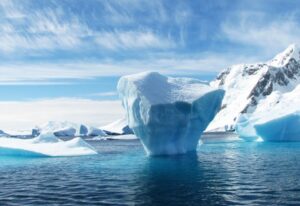Physical Address
23,24,25 & 26, 2nd Floor, Software Technology Park India, Opp: Garware Stadium,MIDC, Chikalthana, Aurangabad, Maharashtra – 431001 India
Physical Address
23,24,25 & 26, 2nd Floor, Software Technology Park India, Opp: Garware Stadium,MIDC, Chikalthana, Aurangabad, Maharashtra – 431001 India

By Aayushi Sharma
Antarctica’s polar vortex, a powerful swirl of winds that typically traps cold air over the continent during the southern hemisphere’s winter, shows signs of unprecedented instability. For the first time in over 20 years, the vortex is on the verge of splitting into two distinct systems, which could have far-reaching climate implications for the southern hemisphere.
The polar vortex usually maintains a stable pattern, with temperatures in the stratosphere at its core dropping to around -80°C (-112°F). However, recent observations have revealed a series of sudden spikes in stratospheric temperatures, accompanied by significant slowdowns in wind speeds. In mid-July, wind speeds within the vortex decreased from 300 to 230 kilometers per hour, triggering a record-breaking 20°C (36°F) rise in temperatures above the long-term average. This pattern repeated in early August, raising concerns among climate scientists.
The potential split of the polar vortex could lead to an unusual warming of Antarctica and set the stage for an exceptionally hot summer in Australia and South America. If the vortex weakens further, it could even reverse direction, a phenomenon known as sudden stratospheric warming, which has only been observed once before in the southern polar vortex, in 2002. That event was marked by repeated temperature spikes and wind slowdowns, culminating in the vortex’s collapse.
Simon Lee of the University of St Andrews warns that even minor disruptions to the vortex could escalate into extreme weather events. Similarly, Chantelle Blachut from the University of Adelaide notes that this year’s polar vortex is being unusually stretched and warped by competing wind patterns, indicating that something extraordinary is happening in the atmosphere.
Adding to the uncertainty, emerging research suggests that climate change may be playing a role in weakening the southern polar vortex. The unusually low levels of Antarctic sea ice in 2023 and 2024, coupled with record sea temperatures, are potential factors. Martin Jucker from the University of New South Wales also points to the 2022 eruption of the Hunga Tonga-Hunga Ha’apai volcano, which injected massive amounts of water into the stratosphere, as a possible contributor to the vortex’s instability.
As the situation develops, scientists remain uncertain about the ultimate outcome. Some models predict a return to above-normal wind speeds, while others indicate a further slowdown, raising the possibility of a near-collapse later this month. The next few weeks will be critical in determining whether this rare event will trigger significant climatic shifts across the southern hemisphere.
References:
https://www.weather.gov/safety/cold-polar-vortex
Banner Image: Photo by Pixabay https://www.pexels.com/photo/iceberg-during-daytime-53389/Photo by Pixabay https://www.pexels.com/photo/penguins-on-ice-48814/